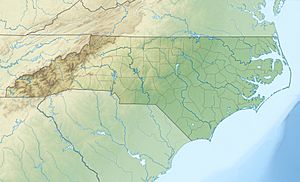Wheat Swamp (Contentnea Creek tributary) facts for kids
Quick facts for kids Wheat Swamp |
|
|---|---|
|
Location of Wheat Swamp mouth
|
|
| Other name(s) | Tributary to Contentnea Creek |
| Country | United States |
| State | North Carolina |
| County | Lenoir Greene |
| Physical characteristics | |
| Main source | Tyson Marsh divide about 2 miles northeast of Institute, North Carolina 33 ft (10 m) 35°22′28″N 077°41′49″W / 35.37444°N 77.69694°W |
| River mouth | Contentnea Creek about 0.5 miles E of Hookerton, North Carolina 7 ft (2.1 m) 35°25′09″N 077°33′11″W / 35.41917°N 77.55306°W |
| Length | 13.97 mi (22.48 km) |
| Basin features | |
| Progression | generally east-northeast |
| River system | Neuse River |
| Basin size | 29.61 square miles (76.7 km2) |
| Tributaries |
|
| Waterbodies | Pulley Pond |
| Bridges | John Harrison Road, Gregory Road, US 258, NC 58, Mike Stocks Road, Oakes Road, Hugo Road |
Wheat Swamp is a small but important waterway located in North Carolina, USA. It flows through parts of Lenoir and Greene Counties. This swamp is about 13.97 mi (22.48 km) long. It is a "tributary" to a larger stream called Contentnea Creek. A tributary is like a smaller river or stream that flows into a bigger one. Wheat Swamp even forms part of the border between Lenoir and Greene Counties!
What's in a Name?
Sometimes, places have more than one name, or their names change over time. Wheat Swamp is one of those places! Long ago, people also called it "Wheat Swamp Creek." This information comes from a system called the Geographic Names Information System. It keeps track of names for places like rivers and mountains.
Where Does it Start and Go?
Every river or stream has a beginning, called its "source." Wheat Swamp starts about 2 miles (3.2 km) northeast of a place called Institute, North Carolina. From there, it flows generally towards the southeast. Then, it makes a curve and heads northeast. Finally, it joins Contentnea Creek. This meeting point is about 0.5 miles (0.8 km) northeast of the town of Hookerton.
Understanding its Home: The Watershed
Imagine a big bowl where all the rain and snow that falls eventually flows into one main stream or river. That "bowl" is called a watershed (or drainage basin). The Wheat Swamp watershed covers an area of about 29.61 square miles (76.7 km2). This means all the water that falls on this area will eventually make its way into Wheat Swamp.
This area gets a good amount of rain, about 49.8 inches (126 cm) each year. A "wetness index" helps scientists understand how wet the land is. For Wheat Swamp, this index is 584.92. This tells us it's a pretty wet area. About 13% of the land in its watershed is covered by forests.



